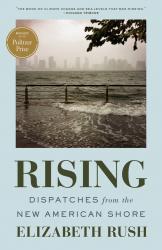We welcome your reviews of books that • were published within the past three years • do not advocate for a political party or politician • do address issues supported by the League, and • intrigued you enough that you want to share them. Please submit your review at any time to Margan and Thad Zajdowicz (Margan.Zajdowicz [at] gmail.com).
Rising Dispatches from the New American Shore
By Elizabeth Rush

Do you ever wonder how global warming, rising sea levels, and melting glaciers might affect you? If the answer is yes, then you will want to read this book, a finalist for the 2018 Pulitzer Prize. If you are an “inlander” and perhaps have never considered the issue, you really need to read it.
Elizabeth Rush is an experienced writer, reporter, and teacher of nonfiction writing, and she brings her considerable talents to this chronicle of the impact that climate change is already having on the low-lying areas of United States. Traveling extensively along the coasts of the eastern seaboard, the Gulf, and Northern California, she interviewed both scientists and residents about the realities of their existence in areas that experience frequent flooding now and may soon be underwater. She explored the many efforts being made to rebuild salt marshes, nature’s sponges. She also spent time in an Oregon forest where scientists and writers are documenting the responses of animals and birds to rising temperatures and changing conditions in migratory flyways. In readable and compelling prose, she makes the climate change crisis very real and very distressing.
As I read through Rush’s narrative, a sense of familiarity struck me: I realized that I had witnessed, at first hand, the damage that rising sea levels and warming temperatures are having on, well, everyone. I moved to California from coastal Fairfield, Connecticut, in 2015, after Hurricanes Irene and Sandy had done incredible damage to New York, New Jersey, and New England. Irene passed to the west of us and took the very unusual path (for a hurricane) up the Hudson River and into Vermont, where rising water and deluging rains wreaked havoc for hundreds of miles. Sandy passed directly over us, and while we were inland and upland from much of the town and suffered only small inconveniences, the parts of Fairfield between Long Island Sound and I-95 (all at or below sea level) were under six feet of water for weeks. Restoring power and telephone lines took more than a month. Once the water receded, many homeowners decided to lift their homes’ living spaces to the recommended 17 feet above sea level. A neighborhood of Cape Cod houses became a strange mishmash of housing heights—a constant reminder of the ocean’s power to change our lives.
Not all who endure the ravages of increasingly intense storms are able to adjust to their devastating impact, however. Rush helps us understand how many who live in flood-prone coastal areas (where land is less desirable) are often poor and vulnerable. They do not have the resources to pay for alternative accommodations during evacuations, for rebuilding after flood damage, or for the flood insurance that would help them repair that damage. Their neighborhoods often suffer from infrastructure neglect. New Orleans’ Ninth Ward is a perfect example: Referring to the devastation visited upon this district in the wake of Hurricane Katrina, Tracie Washington, Co-director of the Louisiana Justice Institute, said, “Stop calling me resilient, because every time you say, ‘Oh, they’re resilient’ that means you can do something else to me. I am not resilient.” What Washington wants—what we all should want—is a realistic plan to save people, animals, and coastal plains from the immediate effects of a changing climate as we gain time to figure out how to deal with what will come next.
—Anita Mackey, Chair, Advocacy Committee